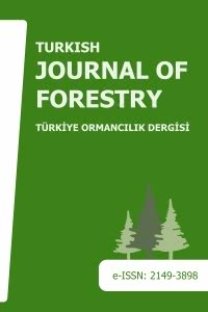Geri dönüşümde yaş pres ve kurutmanın lif özelliklerine etkisi
geri dönüşüm, fiziksel özellikler, odun kusurları, odun direnci, ıslak odun, odun özellikleri
Wet press and drying effects on fiber properties during recycling
recycling, physical properties, wood defects, wood strength, wetwood, wood properties,
___
Allan, G.G. and Ko, Y.C., 1995. The microporosity of pulp. The forces influencing the intra and inter-fiber pore structure and pore size distribution in pulp and paper. Cellulose Chem Techol., 29:479-485.Berthold, J. and Sahnen, L., 1997. Effects of mechanical and chemical treatments on pulp pore-size distribution in wood pulps examined by inverse size exclusion chromotography. J. Pulp Paper Science, 23 (6): J245-J253.
Cao, B., Tschirner, U., and Ramaswamy, S., 1999. A study of changes in wet fiber flexibility and surface condition of recycled fibers. Paperi Ja Puu, 81(2): 117-122.
Carlsson, G. and Lindström, T., 1984. Hornifıcation of cellulosic fibers during wet pressing. Svensk Papperstidning, 15: R115-R125.
Çıldır, H., and Howarth, P., 1972. The effect of reuse on paper strength. Paper Technology, (October): T149-T151.
Ellis, R. L. and Sedlachek, K. M., 1993. Recycled Versus Virgin Fiber Characteristic: A Comparison. In: Secondary Fiber Recycling. (Spangenberg, R.J., ed.), Tappi Press. Atlanta, Georgia.
Fahmy, Y. And Mobarek, F., 1971. On fine structure of cellulose fibers. Svensk Papperstidning, (Jan 15) No. 1: 2-9.
Gürkan, K., 2001. Atık kağıdın önemi ve geri kazanılması. SEKA Kağıtçılık Dergisi, (Kasım) 70:10-11.
Higgins H.G. and Me Kenzie, A.W., 1963. The structure and properties of strength. Appita, 16(6): 145-161.
Horn, R.A., 1975. What are the effects of recycling on fiber and paper properties? Paper Trade J., (Feb 17-24): 78-82.
Howard, R.C., 1990. The effects of recycling on paper quality. J. Pulp Paper Science, 16(9): J143-J149.
Hult, E.-L., Larsson, P.T., and iversen, T., 2001. Cellulose fibril aggregation-an inherent property of kraft pulps. Polymer, 42: 3309-3314.
Klungness, J.H. and Caulfıeld, D.F., 1982. Mechanism effecting fiber bonding during drying and aging of pulps. Tappi J., 65(12): 94-97.
Laivins, G.V. and Scallan, A.M., 1993. The mechanism of hornification of wood pulps. In: Products of Papermaking, C.F. Baker (Ed.), Tenth Fundamental Research Symposium, Pira International, Oxford. (Sep.): 1235-1260.
Lyne, L.M. and Gallay, W., 1950. The effect of drying and heating on the swelling of cellulose fibers and paper strength. Tappi J., 33(9): 429-435.
Maloney T.C., Li, T.Q., Weise, U., and Paulopuro, H., 1997. Intra and mter-fîbre pore closure in wet pressing. Appita, 50(4): 301-306.
McKee, R., 1971. Effect of repulping on sheet properties and fiber characteristics. Paper Trade J., (May 24): 34-40.
Metin, A., 2002. Türkiye selüloz ve kağıt endüstrisinin 2000 yılı genel durumu. SEKA Kağıtçılık Dergisi, (Ocak) 71:14-17.
Minor, J.L., 1994. Hornification- its origin and meaning. Progress in Paper Recycling, (February): 93-95.
Oksanen, T., Buchert, J., and Viikari, L., 1997. The role of hemicelluloses in the hornification of bleached kraft pulps. Holzforschung, 51(4): 355-360.
Oye, R., Okayama, T., Yamazaki, Y., and Yoshinaga, N., 1991. Changes of pulp fiber cell wall by recycling. 1st Research Forum on Recycling the Wasting, Harbor Castle Hotel, Toronto, Ontario, (Oct): 191-195.
Scallan, A.M., 1974. The structure of the cell wall of wood- a consequence of anisotropic mter-microfibrillar bonding? Wood Science, 6(3): 266-271.
Sjöström, E., 1993. Wood Chemistry Fundamentals and Applications. 2nd Edition, Academic Press, San Diego, CA.
Stamm, A.J., 1950. Bound water and hydration. Tappi J., 33(9): 435-439.
Thode, E.F., Chase, A.J., Majmudar, S.S., and Mackinnon, D.R., 1953. Dye adsorption on wood Pulp III. effect of pulp processing on specific adsorption. Tappi J., 36(11): 498-504.
Van Wyk, W. and Gerischer, G., 1982. The influence of recycling on the strength properties of machine made paper. Paperi Ja Puu, 9:526-533.
Weise, U., 1998. Hornification-mechanisms and terminology. Paperi Ja Puu, 80(2): 110-115.
- ISSN: 1302-7085
- Yayın Aralığı: Yılda 2 Sayı
- Başlangıç: 2000
Isparta-Sütçüler yöresi boylu ardıç (Juniperus excelsa Bieb.) meşcerelerinde artım ve büyüme
Kavelalı mobilya köşe birleştirmelerinin sonlu elemanlar analizi
Yaban hayatında habitat envanteri
Su buharı etkisindeki etiket yongalı levha' da (WFB) verniklemenin boyut değişimine etkisi
Orman envanterinde uydu verilerinden yararlanma olanakları
Küme örtüleme modeli kullanılarak optimum yangın gözetleme noktalarının belirlenmesi
